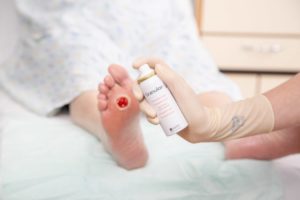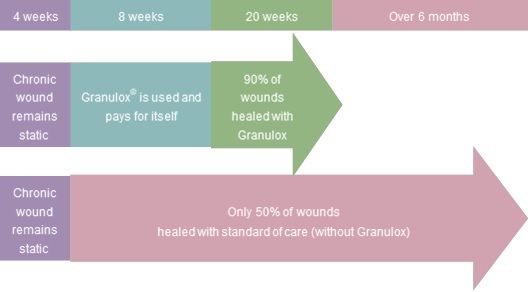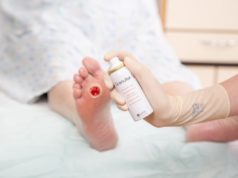
A controlled evaluation of 100 UK National Health Service (NHS) patients has demonstrated savings in chronic wound care costs with the use of Granulox, a haemoglobin spray that binds oxygen from the atmosphere and facilitates its diffusion to the wound bed (used as adjunct to standard wound care therapy).
The analysis highlighted that Granulox pays for itself in terms of cost-savings as soon as eight weeks into treatment based on reduced healing times and therefore reduced need for consumables.
The evaluation ‘Cost-effectiveness of adjunct haemoglobin spray in the treatment of hard-to-heal wounds in a UK NHS primary care setting’ has been published in the Journal of Wound Care. It followed 50 consecutive patients treated with Granulox as an adjunct to standard care (intervention group – dressing changes completed by patient and/or carer) over 26 weeks, and compared their wound healing process against 50 consecutive retrospective controls treated with standard care only (control group – dressing changes completed by healthcare professionals), in the same clinic, in the year before the introduction of Granulox.
Patients in the intervention group received Granulox application with each dressing change and in line with the manufacturer’s instruction for use. Cost savings were calculated against actual costs of consumables. In the evaluation, the hard-to-heal wounds included pressure ulcers, leg ulcers or diabetic foot ulcers, as well as burns, surgical and trauma wounds that had failed to heal normally.
A cost-effectiveness and break-even analysis of the clinical results demonstrated that at eight weeks enough dressing costs are saved to pay for treatment with Granulox, making it a cost-effective solution in chronic wound care management (before calculating the benefit of reduced cost of clinician time saving). There was an average saving of £82 on dressings per patient at 26 weeks. At break-even point, the cost of dressings for patients treated with Granulox was £140 compared to £221 for patients treated in the control group.

“The impact of non-healing wounds on a patient’s quality of life can be devastating,” said Duncan Stang, podiatrist and National Diabetes Foot Coordinator for Scotland. “The ability to help these patients without a financial burden to the NHS, and in fact demonstrated cost savings, is an invaluable opportunity. The analysis does demonstrate cost-effectiveness – which is excellent – and what is also really interesting about this work is the reduced healing times: benefitting patients and of course healthcare teams who are working in an ever stretched NHS, particularly in wound care.”
At 20 weeks, 90% of wounds treated with Granulox healed. The analysis calculated that for Granulox to pay for itself it would need to be effective on 72% of patients. Without the haemoglobin spray, in the control group, half of the patients were still not healed in over six months.
This publication adds to previous cost-effectiveness evidence of Granulox, published by Health Improvement Scotland, which reported expected average cost savings of £2,330 per patient in diabetic foot ulcers, £1,469 per patient in chronic wounds, and £849 per patient in sloughy wounds over six months. This evaluation estimated total cost-effectiveness not only on dressing costs. Dressing materials and nurse time were included in the analysis, as well as surgical procedures related to chronic wounds including surgical debridement and amputation.
Wound care management is costly for the NHS. A retrospective cohort analysis data from The Health Improvement Network estimated that the NHS treats more than two million patients annually in the UK at a cost of £4.5–£5.1 billion at 2012/2013 prices. Over a third (39%) of these wounds were not healed within the study period and the costs of treating them ranged from £1,719 to £5,976 per patient.













